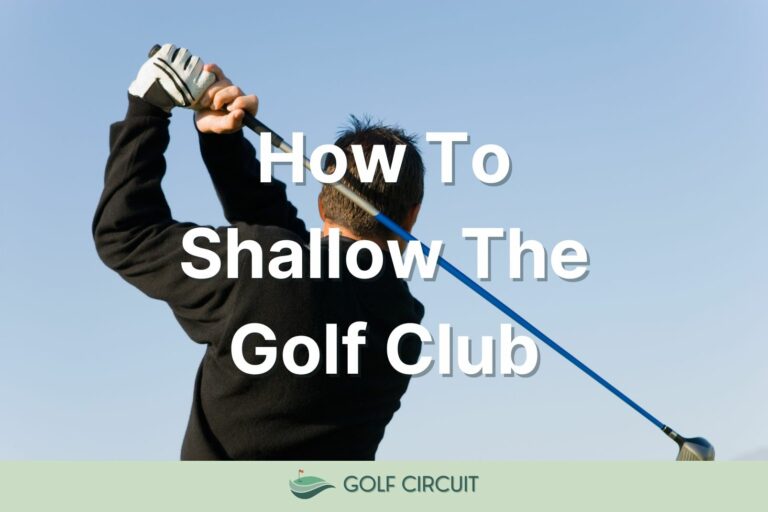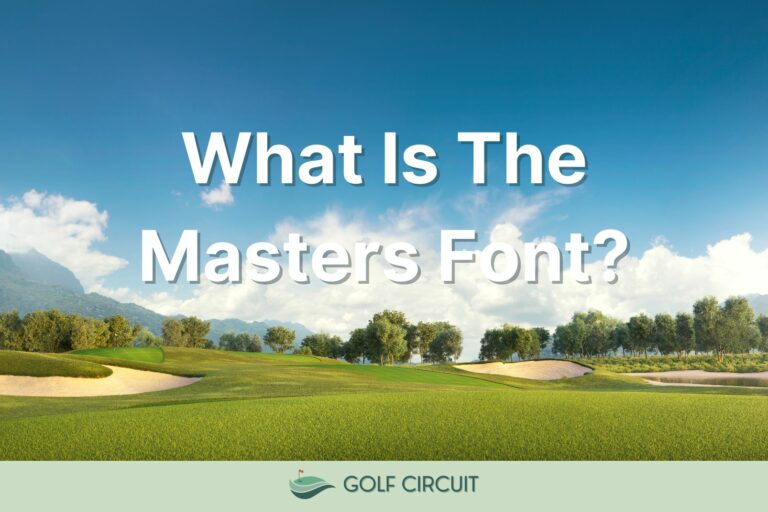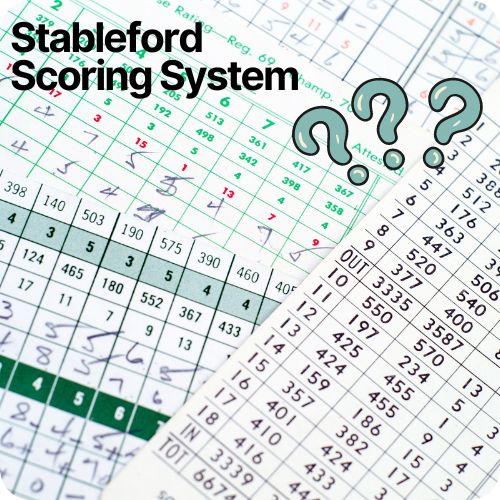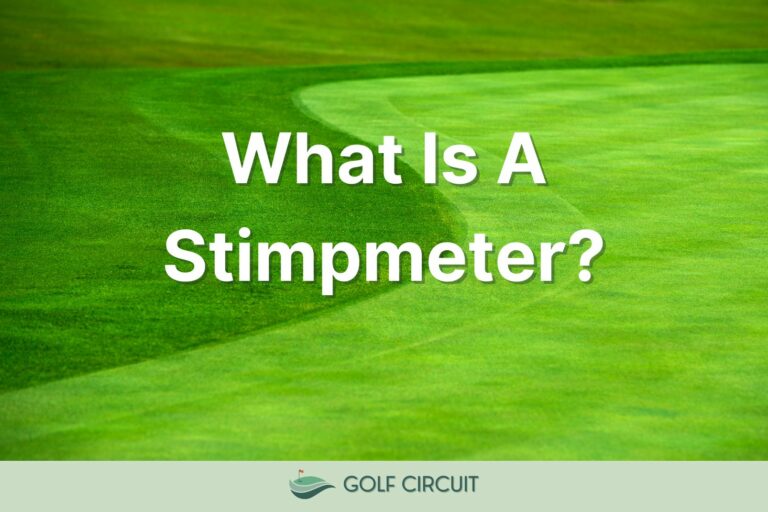We Tested the Most Expensive Golf Balls in 2023
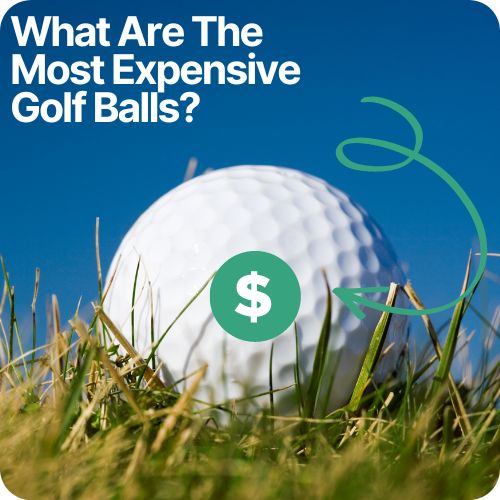
It is no secret that golf is not a cheap sport. When looking at equipment and first trying to break into the game, it becomes obvious that golf is largely played by rich people.
Nonetheless, it has become extremely popular with younger generations, and with all of the money flowing into the sport, developments must be made for better technology.
Arguably one of the most important pieces of equipment is the golf ball, which can get pretty expensive as you will see here.
Our Top Picks For The Most Expensive Golf Balls
- Titleist Pro V1 – Most Expensive Golf Ball
- Titleist Pro V1x – Most Expensive Golf Ball For Distance
- TaylorMade TP5 – Best Looking Expensive Golf Ball
7 Most Expensive Golf Balls
Titleist Pro V1
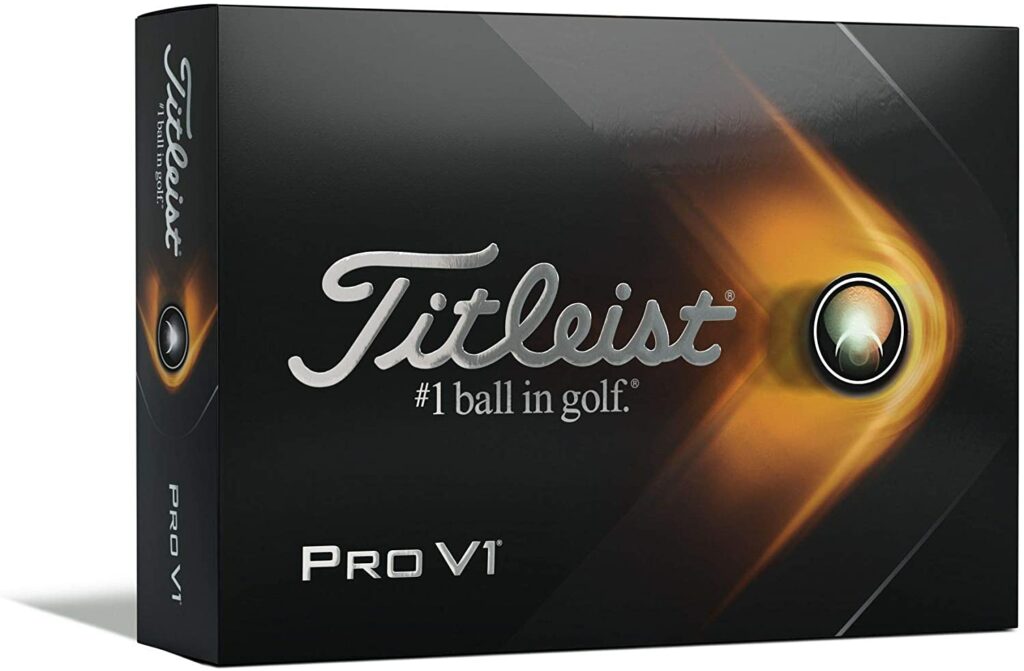
Key Feature
The proprietary 388 dimple pattern on the Pro V1 separates it from the rest of the pack.
This was a major renovation when this ball first rolled off the line, producing reliable (and consistent) launch angles and all flight properties that let the Pro V1 slice through the air.
As famous a golf ball as there is today, almost every single professional golfer in the United States has played a Pro V1 (or a Pro V1x) that some point in their career.
The “gold standard” of what the most expensive golf balls should be or may construction and quality standpoint, the Pro V1 is no longer the priciest ball on the market today – but it’s still going to set you back a decent amount of money all the same.
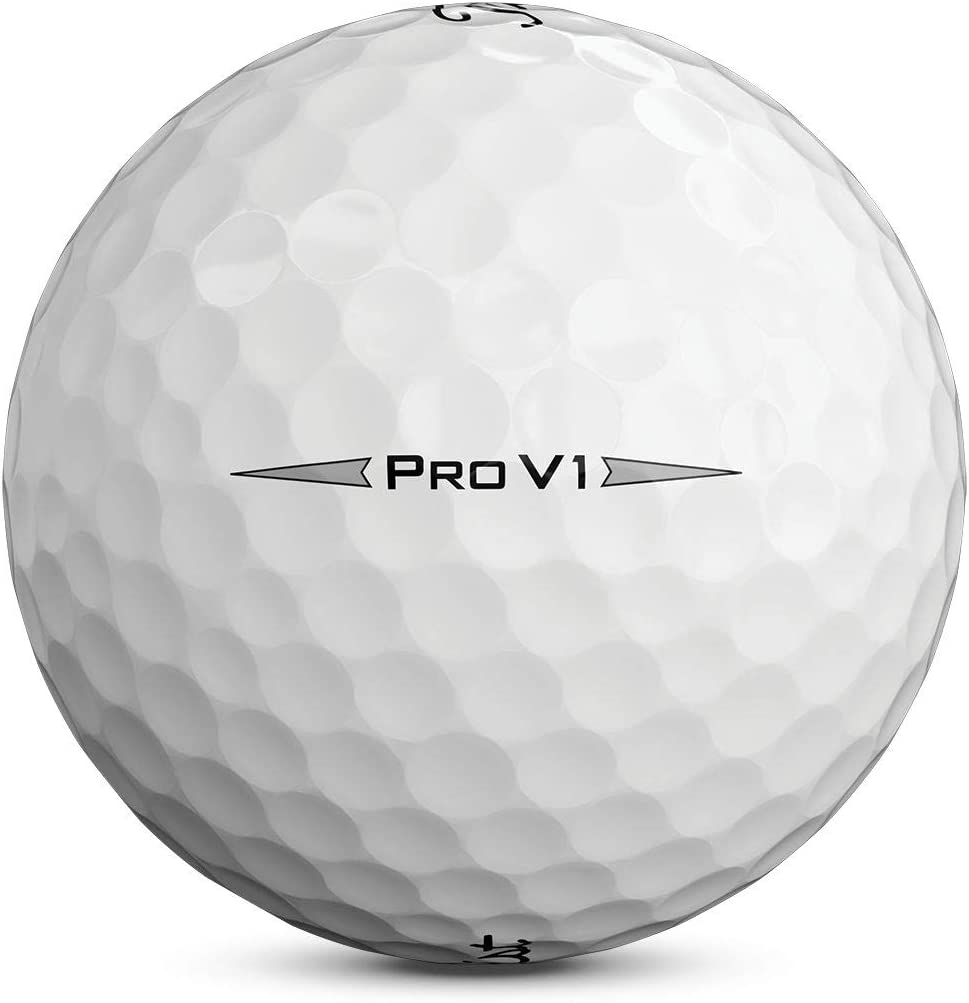
You get what you pay for, though. This is a great golf ball!
Pros
- Maybe the most famous golf ball on the planet, used by more pros than anything else
- Excellent spin rates around the green, giving players confidence and control when coming in to score
- Cranked up ball speed numbers help this ball jump off club faces
- Very soft feel and easy “workability”
Cons
- Slower swing speeds with have a tough time making the most of this ball
- Cover lacks some durability
- Not the “coolest” golf ball in the game anymore
Titleist Pro V1x

Key Feature
Featuring 40 less dimples than the Pro V1, the Pro V1x is designed to help players squeeze even more distance off of their tea and iron shots.
On top of that, the Pro V1x has a 2.0 ZG Process Dual Core in the middle of the ball.
This core causes the ball to have a compression rating north of 110 so that it really launches off of the clubface.
Taking all the good things from the original Pro V1 only “tinkering” with the recipe a little bit, the Pro V1x has been engineered to squeeze a little more distance out of your swing (while sacrificing just a little bit of softness around the greens).
You won’t be sacrificing compressibility a lot, though.

You’ll still be able to enjoy a lot of control with your wedges and shorter irons, helping you hit the green and then stick there when you need to most.
Pros
- Same Pro V1 feel with a lot more distance, making it a great golf ball for high handicappers
- Still spins really tight around greens
- Dimple pattern slices through high winds and humidity
- Plays really well off of all iron shots
Cons
- Super soft cover splits and scuffs faster than most other options
- Feel takes some getting used to, especially if you’re not used to 4 piece construction balls
- Higher trajectory from wedges and high irons takes some getting used to
Titleist AVX
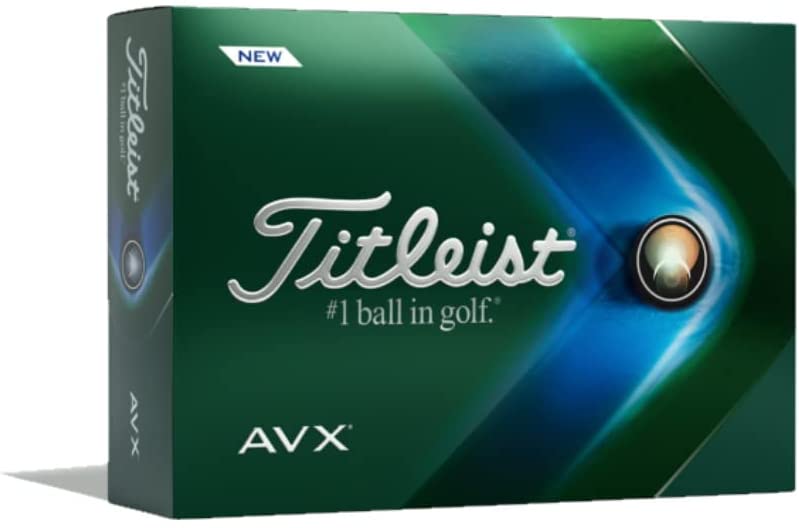
Key Feature
Engineered to have a lower flight pattern, punching through strong winds and heavy humidity without sacrificing short game spin along the way.
Elastomer cover (versus softer urethane covers with balls) helps this ball check up and stop on greens, too.
Though not quite as famous as the Pro V1/Pro V1x line of golf balls from Titleist, the AVX series is nothing to sneeze at.
Think of these balls as the result of the research and development team at Titleist getting to go crazy with their ideas, experimenting with new materials and construction approaches to come up with a new golf ball.
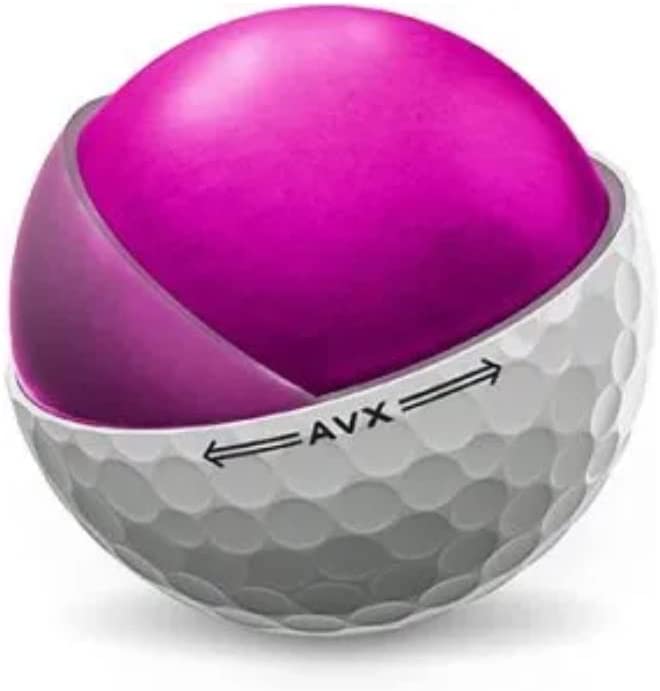
A larger core, a 348 catenary dimple pattern, and the elastomer cover all help these expensive golf balls produce better short game results for those that want to drop their scores.
Pros
- Buttery soft feel, short game magicians will love the way this plays
- Spin rate sticks and stays low on full power shots, giving players a lot of touch and control
- Perfect launch angle coming into greens thanks to the unique dimple pattern
- Excellent off of putter faces
Cons
- Slower swing speed golfers are going to struggle with this ball
- More expensive but not much better than the traditional Pro V1
Callaway Chrome Soft
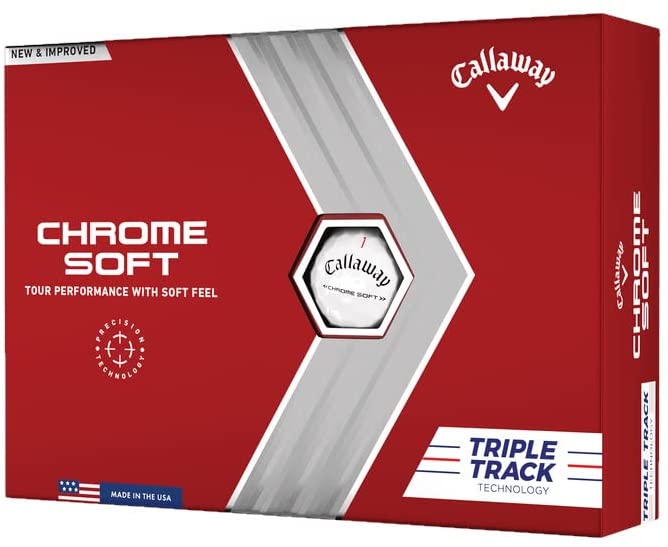
Key Feature
Unbelievably soft feel and lower level of compression makes these golf balls more accommodating to golfers with slower swing speeds.
Straighter ball flight helps corral extreme slices and hooks, too.
It took Callaway a little longer than other golf ball companies to produce a really premium ball option that tour level players wanted to keep in their bag, but the Chrome Soft was worth the wait.
Underneath the almost impossibly soft cover (providing a lot of control and a lot of feel, even to golfers without high swing speeds) sits a larger graphing infused inner core.
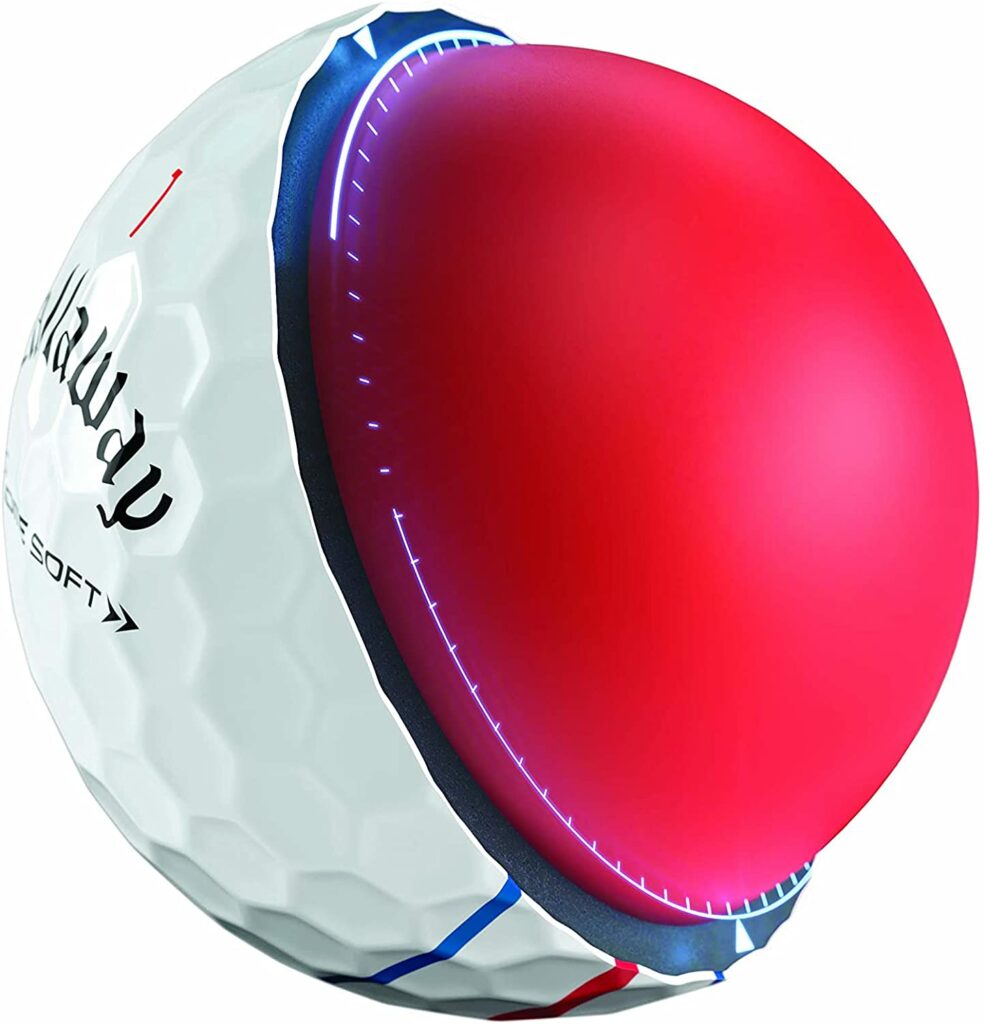
The inner core ratchets up your ball speed after being struck, reduces spin rates in your longer shots, but also helps to deliver a lot of touch around the green, too.
Pros
- Incredible touch and feel, with all clubs in your bag
- Oversized core cranks up speed and promotes longer distances and better launch angles
- Short game spin is dialed in thanks to the stiffer mantle
Cons
- Super soft feel can sometimes be too much, almost squishy
- Covers are going to get torn up in a hurry – even just from club grooves!
TaylorMade TP5
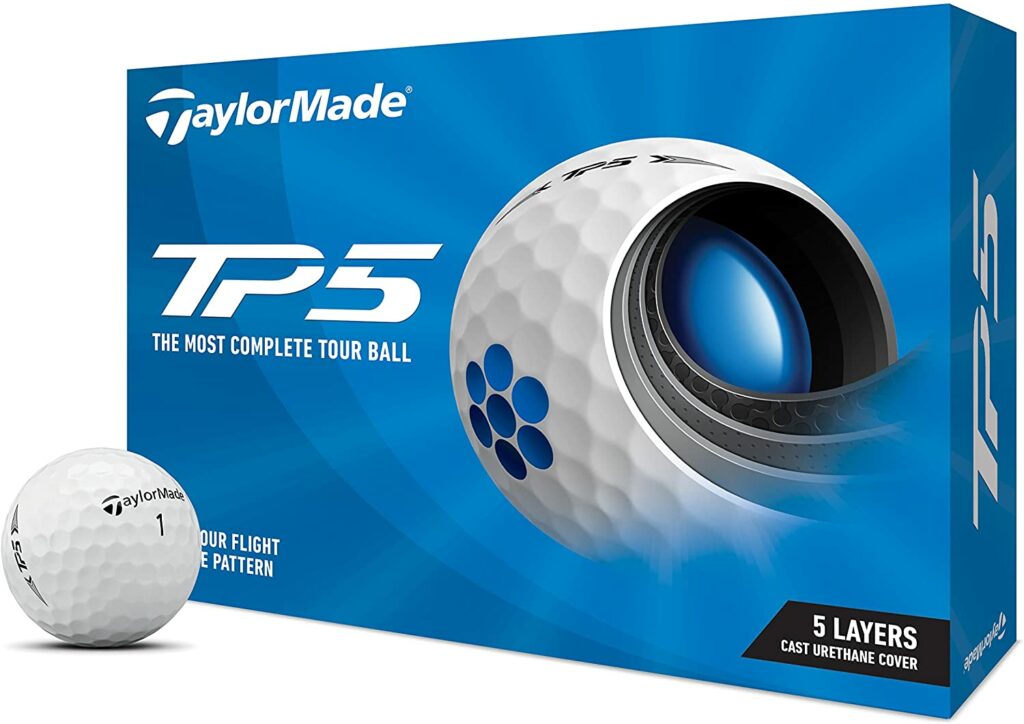
Key Feature
Five layer construction features some of the most engineering in the world of golf balls today.
Oversized Reactiv Tri-Fast core pumps out almost explosive ball speed, stretching carry distance.
High flex materials throughout the five players bump ball speed up even more, too.
Designed by the folks at TaylorMade to go toe to toe with the Titleist ProV1 series, this ball is a little faster, little more explosive, and can perform well even when struck by more moderate swing speed golfers.
A lot of the technical materials squeezed “under the hood” of this golf ball were carefully considered and selected to help ratchet up ball speeds.
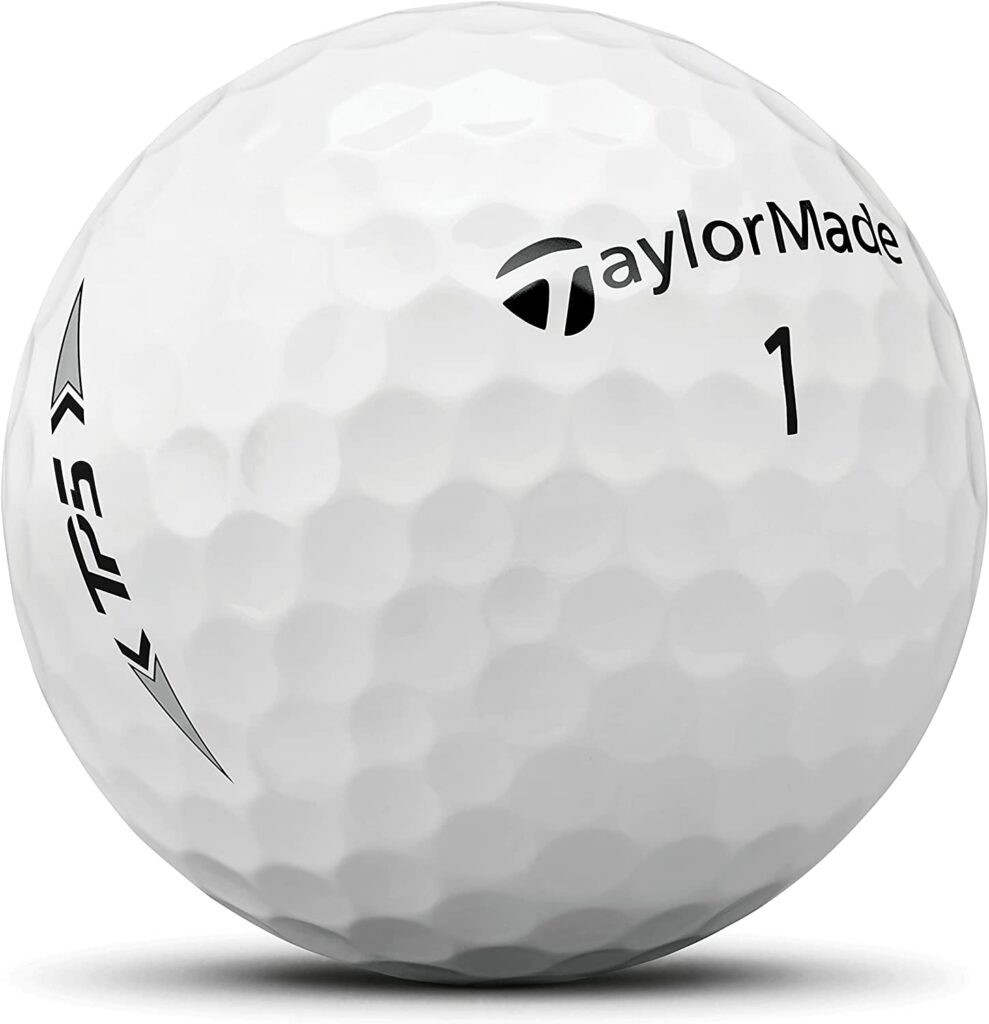
You’ll be able to cut through the wind, launch high and beautiful drives, but also drop your ball gently onto the green with a lot of control (the right amount spin), too.
Pros
- Instantly reactive, with a bigger core for generating higher ball speeds off your clubs
- Very high spin rate from woods and low irons
- “Sticky” when you get closer to the greens, with plenty of performance to check up and walk back
- Five layer construction helps you make the most of your short game
Cons
- Cover of the ball is a little busy and somewhat distracting
- The material on the cover is real soft, meaning it’s going to chip, scuff, and breakdown
- Not as proven as other choices
Bridgestone Golf Tour B XS Model

Key Feature
The Reactiv Urethane Cover helps players get the most out of full swing, long distance shots by lowering spin rates are also accelerating ball speed, adding a couple of yards to your shots while helping them fly straighter and with more accuracy.
On shorter shots (wedges and short irons) the cover absorbs impact, cranks up the spin rate, and gives players a lot more control.
There are (currently) for different iterations of the Tour B golf ball from the folks at Bridgestone – and every single one of them are worth a closer look.
The B XS, though, is considered to be the cream of the crop. It’s the ball that players on tour reach for, including players like Tiger Woods.
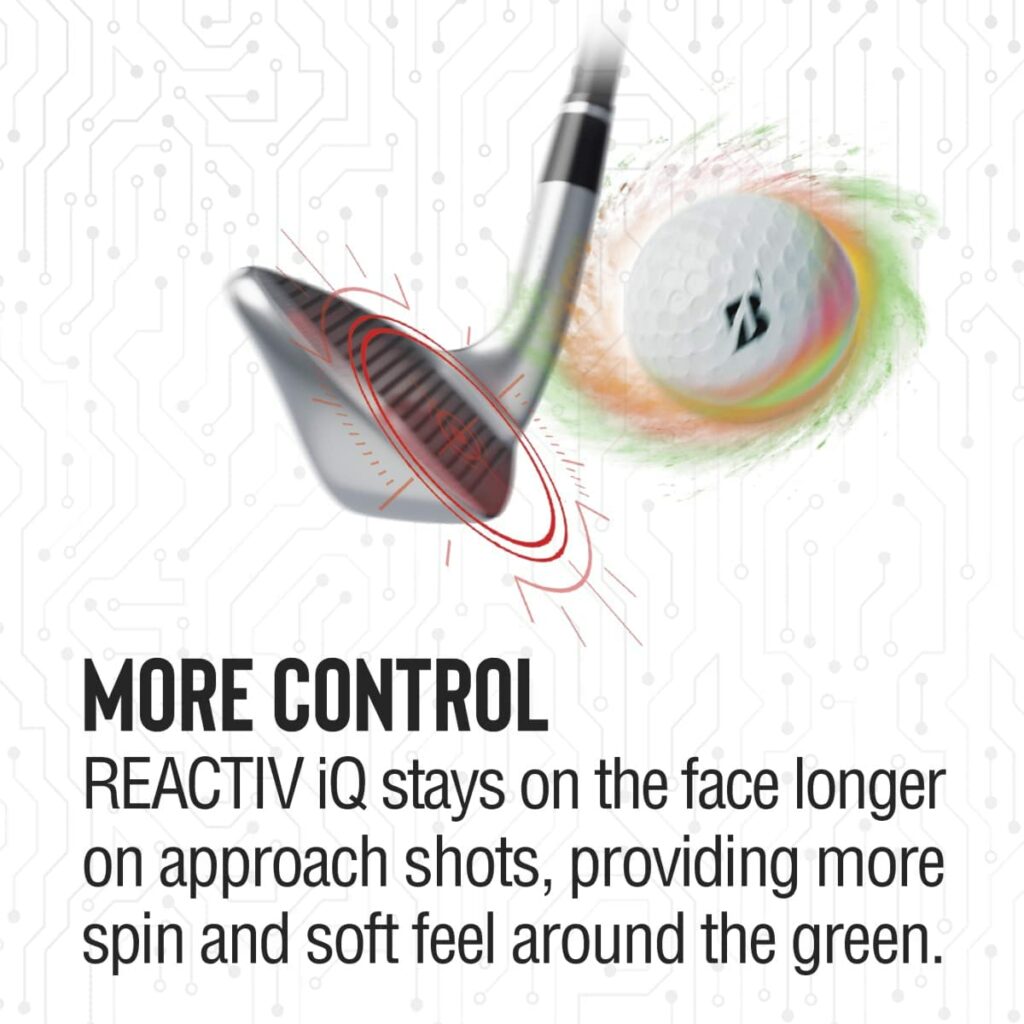
Perfect for those with a faster swing speed, even more moderate swing speed players are going to be able to make the most of the engineering that went into this ball, too.
That’s thanks to the Dual Dimple and seamless cover technology, the special cover material used, as well as the proprietary “Graduational Compression Core” in the heart of this ball.
Pros
- The ball of choice for golf legend Tiger Woods (what an endorsement)
- Proprietary urethan cover blend boost distance significantly
- Dual dimple system produces a more controllable (and workable) ball flight path
- “Shock absorbing” capabilities means you have more control when you’re approach or already on the green
Cons
- High swing speeds are necessary to make the most out of this ball
- Cover becomes real rough after 3-5 holes
Dixon Fire

Key Feature
The materials used to produce this ball are almost all recycled, making this the most environmentally friendly high-performance golf ball money can buy right now.
The Green Core at the center of this ball guarantees that it’s not just a marketing gimmick, though – the ball performs well off the tee and around the green.
Dixon Fire golf balls usually are usually the most expensive golf balls available. However, it’s not unusual for the Dixon Fire golf balls to command the kind of price that would get you a dozen and a half Pro V1s.
A three-piece ball, the outermost layer is a cast urethane cover that is soft and responsive. It’s also made from recyclable (and recycled) materials. That’s huge for golfers that are a little more eco-conscious.
Underneath that cover, though, are the “Energy Intensifying Mantle” and the “Green Core” sitting at the center of the ball.
The Energy Intensifying Mantle reduces overall long game spin when struck with full shots from a driver and longer irons.
That’ll help to contain slices and hooks, produce more repeatable and reliable ball flight, and make approaching the green much easier.
The Green Core, on the other hand, works to crank up ball speed and spin rates when struck with shorter irons and wedges.
Golfers will be able to pop their ball high into the air, drop it right down on the “table” of the green, and get a gentle release, freeze the ball while it checks up, or even walk the ball back towards them and the hole – all depending on what they’ve done with the club, course.
Pros
- Very low spin rates without having to sacrifice extreme distance and control
- Drops out of the sky and sticks to greens like glue
- Proprietary dimple pattern gives skilled golfers a lot of control
Cons
- Ideally suited for lower handicap and higher swing speed golfers
- Very, very expensive – more than (almost) any other golf ball available
- Cover isn’t quite as durable as other options
FAQ
Why are some golf balls more expensive than others?
While a golf ball might not look like much on the surface, there’s a lot going on “under the hood” that heavily influences how expensive one ball is compared to another.
For starters, if you were to cut a golf ball open you’d find it’s made up of multiple individual layers. It’s not just one big mush of rubber under the golf ball cover.
Each of these layers play a part in the capabilities of the golf ball. The more layers there are, the more engineering that went into the ball – and the more complex the manufacturing process inevitably was.
The cover itself isn’t something just slapped together, either.
The amount of dimples, the dimple pattern, the depth and spacing of dimples – all of that comes together to influence just how well a ball performs when struck (and how much it costs to produce).
Are the most expensive golf balls the best options for all golfers?
Make no mistake about it, you (almost) always get what you pay for when buying golf balls.
The cheapest range balls on the market are going to feel like hitting stones when you make contact.
They aren’t going to cut through the air with ease and they aren’t going to land softly – with plenty of spin – when they splash down on the green, either.
Expensive golf balls, on the other hand, generally perform much better (and more consistently) than their cheap-o counterparts.
They fly straighter and further. They can be “worked” into a controllable draw or fade. They can punch through strong wind and high humidity.
And they can drop onto a green like a cruise missile, land softly with a bounce or two, and then check up – or release – to give you a great chance putting.
All that said, not every golfer is going to be able to make the most of the next level engineering that goes into these world class (and pricey) golf balls.
Weekend warriors and occasional hackers just out to have some fun are going to have a round ruined if they start losing expensive ProV1s in the woods or water every other hole.
If you want to play your best, and are serious about golf, the more expensive balls can help.
If you’re just looking to knock around a round of 9 or 18 holes with some friends every now and again, though, you can get away with less expensive (and still halfway decent) balls for sure.
Does all this “golf ball tech” really make a difference?
Yes, yes it does!
It sounds crazy on the surface – just how much can go into building a better golf ball, anyway? – but there’s a ton of engineering that goes on behind the scenes to make EVERY decision about the golf balls that you buy.
The more expensive options on the market (the premium Titleist, the Callaway, the Dixon balls) are all going to try and squeeze as many performance enhancing features into each ball as possible.
Dimple counts and dimple patterns. Type of ball cover material. How many layers of material. How much – and what kind – of rubber to use. And so on.
Some of this stuff is marketing hype, to be sure. And there’s no small amount of golfers paying more for balls that pros play just because pros play them, too.
But there’s also a lot of built in advantages that more expensive (and better engineered) golf balls bring to the table, too.-
What should I look for in good golf balls?
These are the things that should inform your golf ball buying decisions:
- Your budget – If you’ve got the dough to splash on better golf balls, it’s a good idea to do it
- Your game – If you can utilize the kind of extra distance, spin rate boost, and soft landing that premium balls deliver, it’s a good idea to get them
- Brand reputation – The big brands in the golf ball (and golf club) world became big names on the back of gear that performs. Professionals aren’t trusting their livelihoods to companies that can’t deliver on their promises. Stick to brands you know you can trust.
- Feel – You need to try a couple of different balls out before you settle on the ones that work best for you. Get your hands on some sleeves (three balls in each) and go knock them around the course for a few rounds. Keep notes about what you like and what you didn’t. You’ll find the balls you should be using in no time with this approach.
Material choices, construction quality, and overall durability are other things that should be top of mind when shopping for new golf balls – especially those with a premium price tag.
How to find deals on the most expensive golf balls for sale today?
There are a couple of tried and true ways to get your hands on premium and (normally) expensive golf balls without having to spend a small fortune every time you need a dozen.
For starters, consider buying in bulk for big discounts.
There are a whole bunch of local as well as online shops that will cut you a big deal when you bulk order golf balls. We’re talking at least 5-10 dozen balls at a time here.
That might seem like a lot of balls to have around at first. But when you realize just how consumable these things are and that they last forever – not to mention that you literally cannot golf without some – it becomes a bit of a no-brainer.
Secondly, you want to consider buying golf balls at the end of your golf season – and buying in bulk whenever possible.
Snap up closeout deals and stock up for the upcoming season when you can. Especially if the golf balls you like are tinkered with all the time (the way that Titleist balls often are).
Companies will want to move merch they haven’t already as the season winds down. They’ll want to clear inventory to make sure they have room for the new stuff next year, too.
Jump on these deals.
Finally, it might not be a bad idea to get your hands on used balls.
There are a bunch of reputable sites online selling some of the most expensive golf balls money can buy at deeply discounted prices, all because these balls have been used before.
Settle for nothing less than AAA or AAAA quality, though. You don’t want balls that are chewed up, balls that have spent years underwater, or balls that are otherwise coming or falling apart.
AAA/AAAA premium used golf balls are often found for 30-50% or more off of traditional retail prices (and perform just as well as brand new balls, too!).
Final Thoughts
Finding a good golf ball isn’t difficult, but one thing we have learned from testing the most expensive golf balls is that you get what you pay for.
Not only that, but we found that when using pricer golf balls, we tend to be more careful with out shots. (Don’t want to lose them in the woods!)
However I understand not everyone can or wants the best of the best when it comes to golf balls. Pick whatever is in your price range, especially if you are just learning the ropes of the game.
Regardless, have fun with what you have! I have had stellar games of golf using a stray ball I found in the woods.


